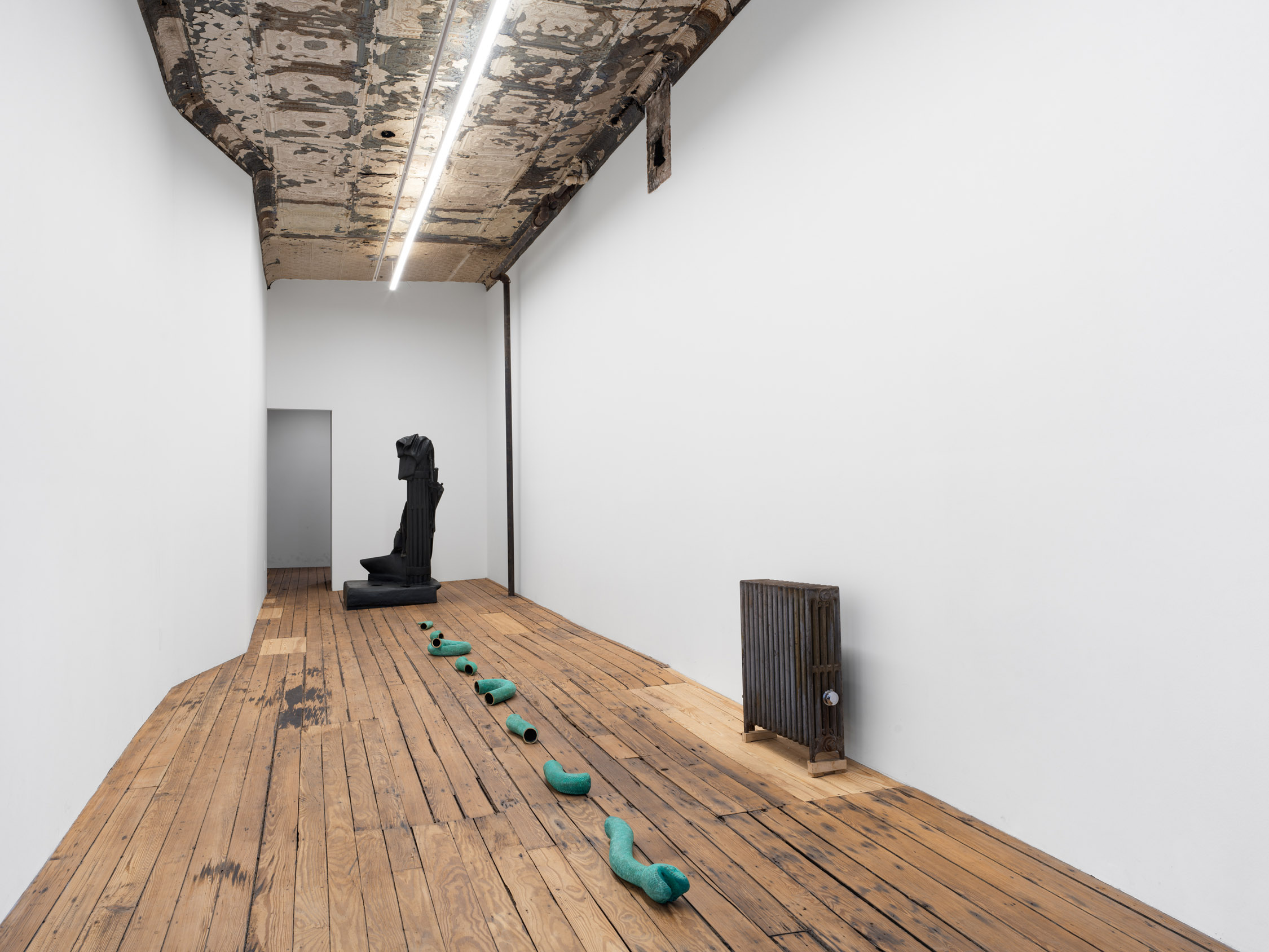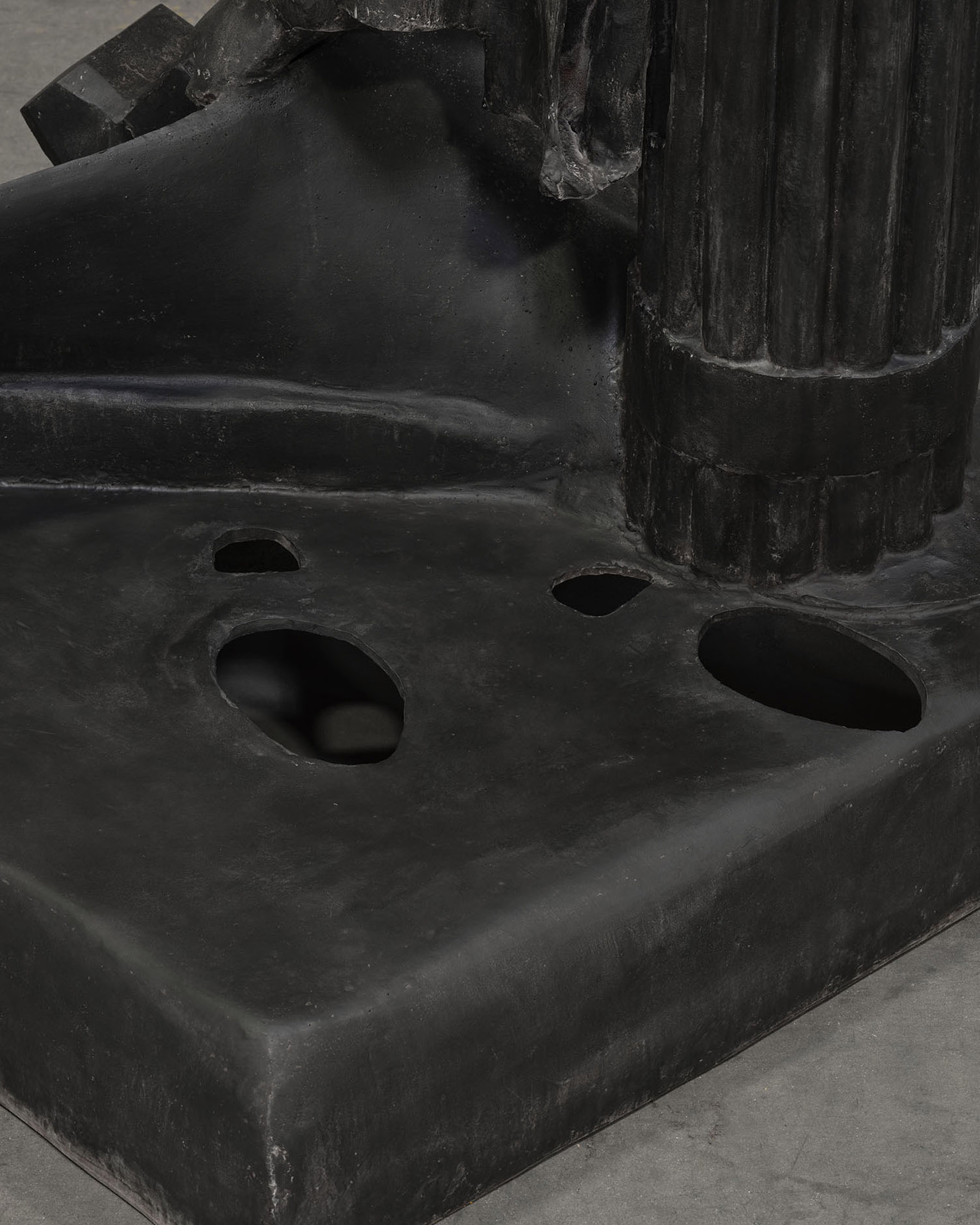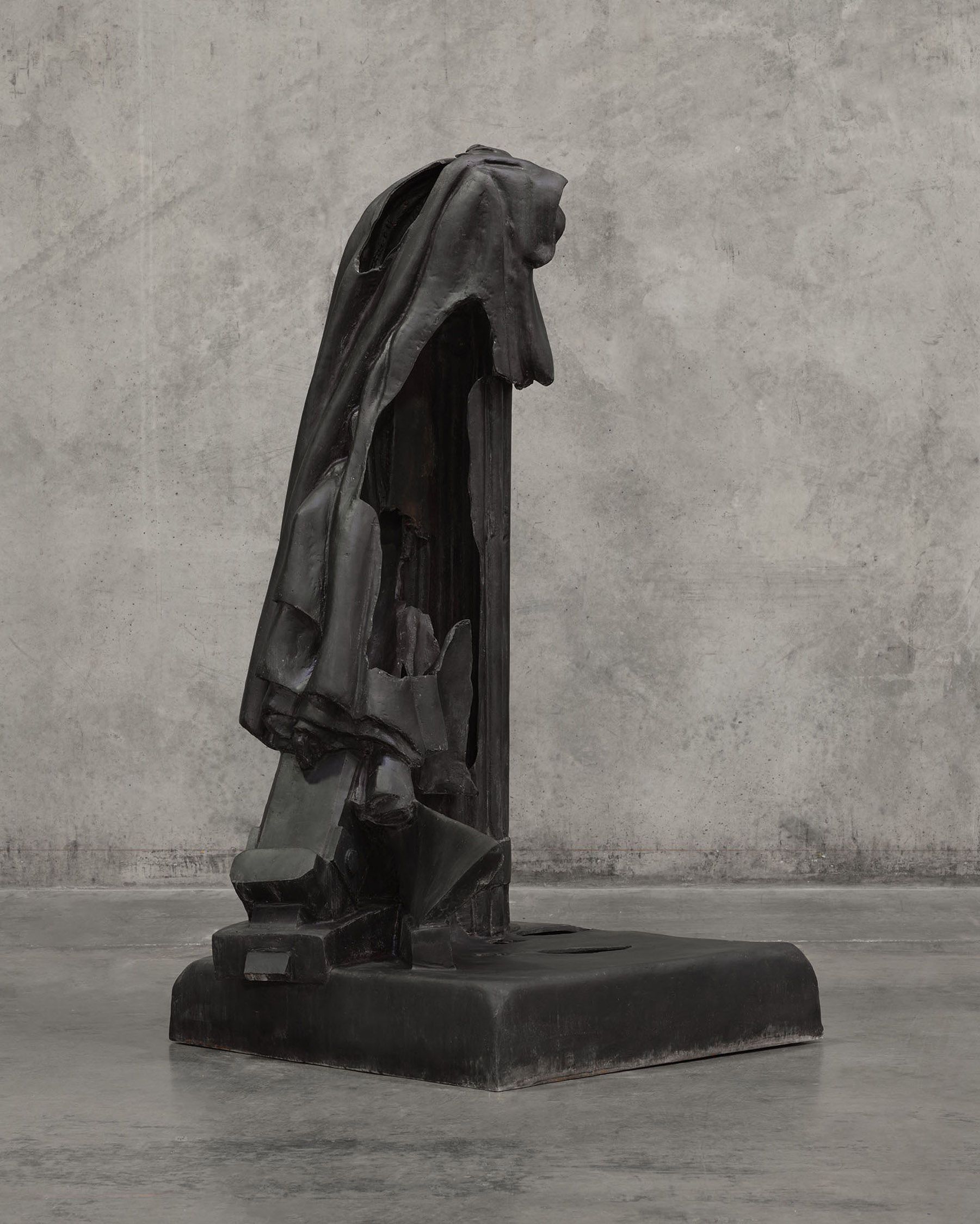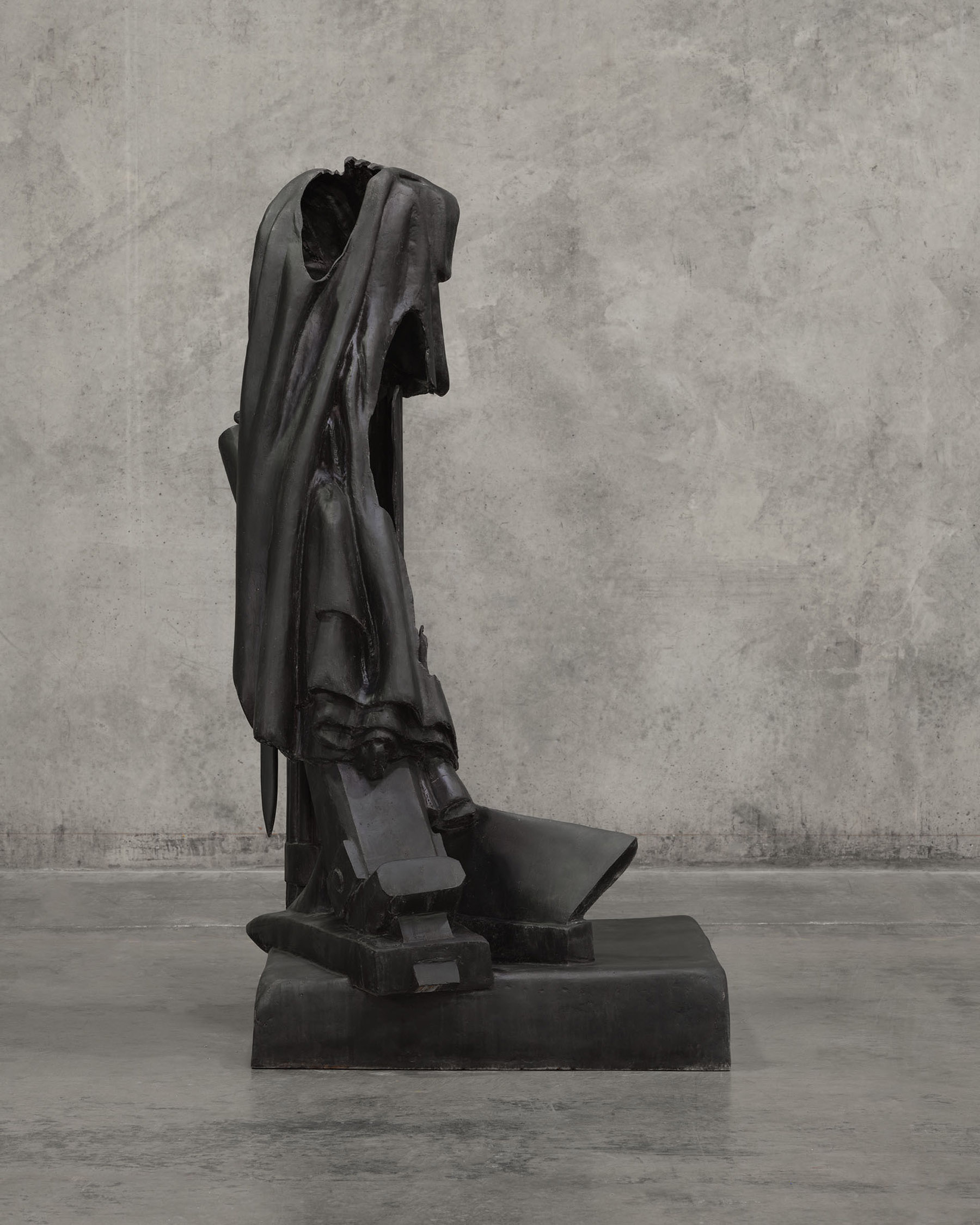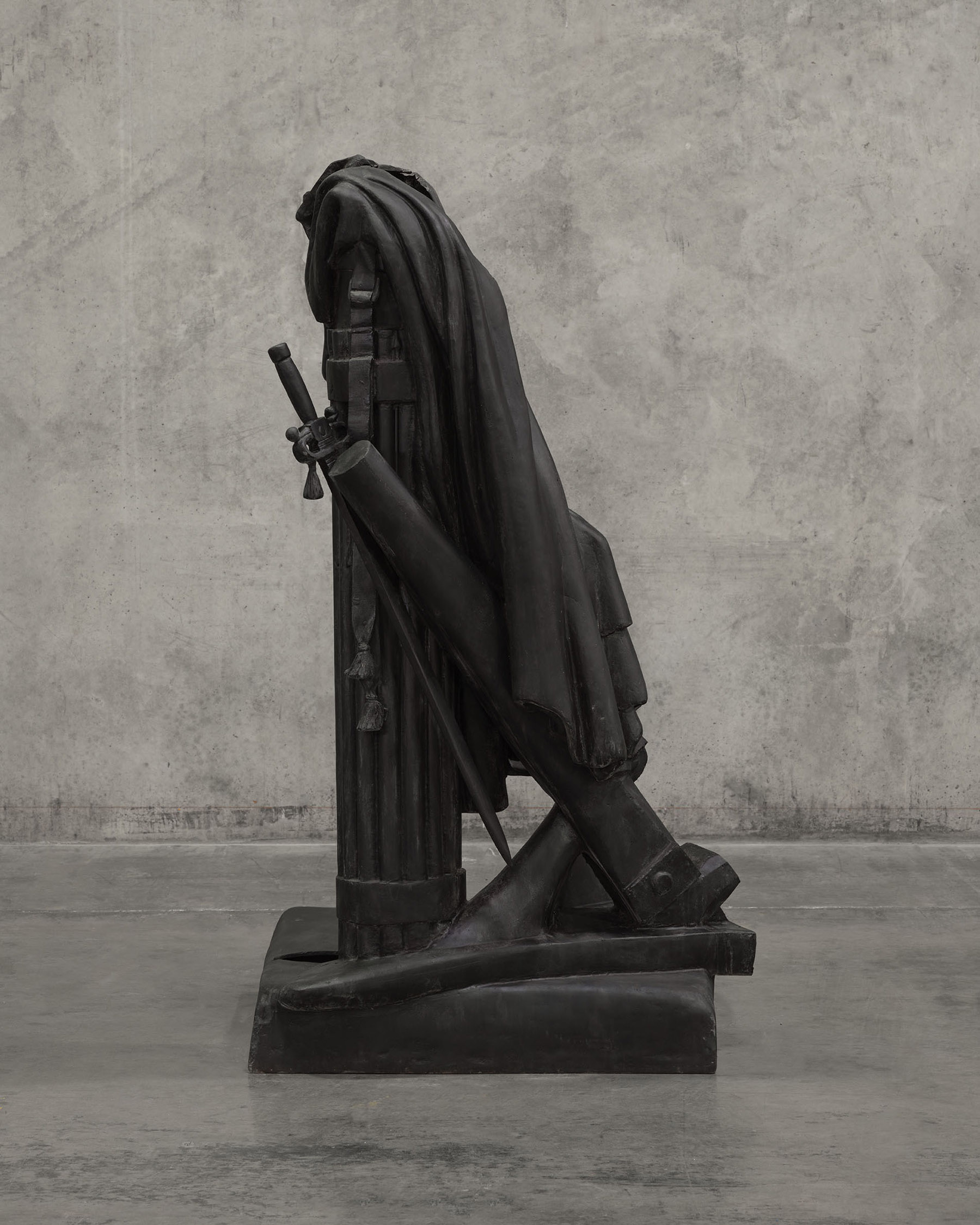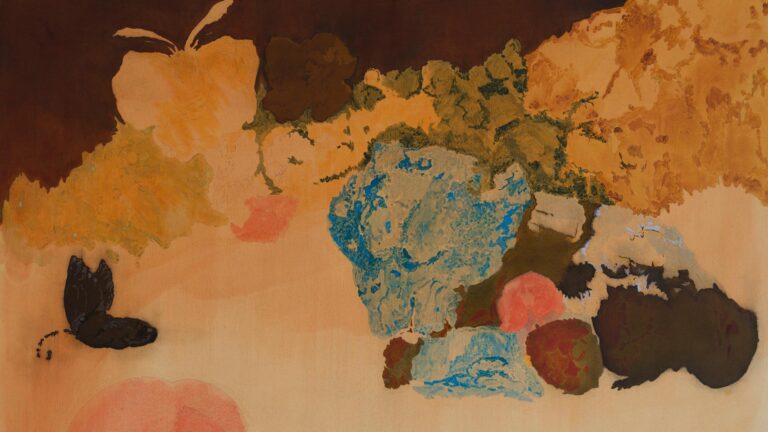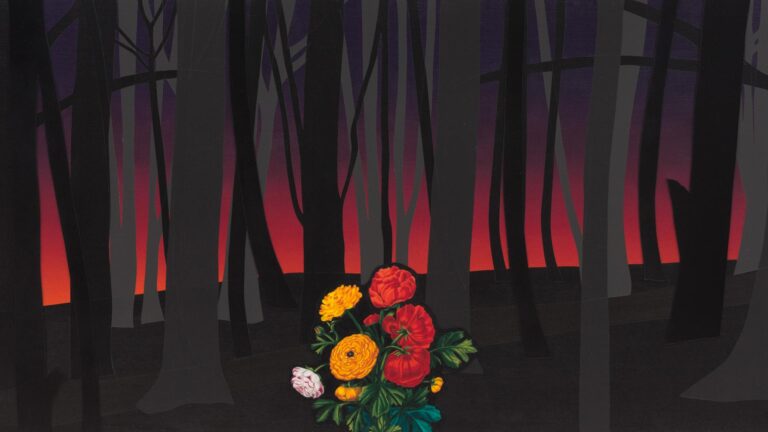Post Times is pleased to present Sean Townley’s first New York solo exhibition.
Sean Townley is a Los Angeles-based sculptor whose research-driven practice examines historical symbols embedded in monuments, architecture, and other marked sites, and their changing meanings over time. Many of his sculptures involve literal or metaphorical breaking but are not merely ‘iconoclastic’—a word that implies the social, political, or religious beliefs that are wielded against images. Rather, Townley’s artworks visualize a contestation between such belief structures and create spatial contexts for confrontation, imagination, meditation, and even surprise. Townley insists that remnants of the past are deeply entwined with the present day, and ought to be interrogated, as we weigh that which we accept versus what is cast aside.
Townley’s Fasces with Plow (2024) is a sculpture modeled after a replica of Jean Antoine Houdon’s eighteenth-cen-tury statue of George Washington (1785-92), recast in black acid-etched aluminum. The strong and acrid flavor of Townley’s artwork reminds the viewer not only of today’s urgent threat to American democracy, but also a historically complicated and fragile relationship between American values and authoritarianism.
Houdon’s original marble representation of the first president stands prominently in the Virginia Assembly house in Richmond, and is widely reproduced in bronze, appearing in collections and public places throughout the Unit-ed States. It is undoubtedly the most recognizable three-dimensional likeness of the first president. The success of Houdon’s statue is found in its depiction of Washington with attributes resonant with Americans of then as much as of today: a hero in military uniform; an upstanding civilian, outfitted with a stately walking cane; and a humble farmer with one foot resting against a plow. In Townley’s version, the excision of Washington’s body from its expected posi-tion allows the beholder to settle their attention instead on other attributes; of these, the shoulder-height bundle of fasces, an ancient Roman symbol, occupies the greatest visual weight. For Houdon, the fasces served to balance Wash-ington’s relaxed, leaning stance, but for Townley, the bundle of rods becomes fully manifest to the eye—a presence that was always there, but in Washington’s absence, one that comes solidly into its own.
Roman symbols like the fasces were important to the new nation in establishing a distinct iconography. At its found-ing, the United States modeled itself on ancient Rome, building upon the republic’s admirable qualities of represen-tative democracy and mindful of the imperial excesses that led to its decline. In antiquity, the bundled fasces were a flogging kit used by the bodyguards of Roman magistrates and thus a symbol of state power, and since then, fas-ces have represented the potential of government to protect the rule of law through punishment. But in the United States, this negative interpretation was largely repressed in favor of one more anodyne: the American fasces often contain thirteen rods, one for each of the original colonies, and over the years came to symbolize the strength of unity more generally, as in the traditional motto, “E Pluribus Unum,” or “Out of Many, One.” The aspiration toward unity remained relevant throughout the fractious nineteenth century, and by 1857, two large bronze fasces in relief were in-stalled in the House of Representatives, flanking the Speaker’s rostrum, as a symbol of hope for national togetherness to be brought about by political compromise.
What’s interesting is that the fasces remained unobjectionable even when their coercive origins were revealed. By the 1930s, attentive viewers of Houdon’s Washington, recently popularized by the nationwide celebration of the presi-dent’s bicentennial birthday, readily identified the fasces as the chosen emblem of Benito Mussolini’s National Fascist Party at the time governing Italy. To Mussolini, the fasces symbolized the brute force behind his dictatorship, a secret police of approximately 50,000 agents that infiltrated every aspect of Italian life. Although today we know the Nazi Party as the ultimate example of fascism, in the earlier years it was Mussolini’s antisemitic and imperialist policies that influenced Adolf Hitler as he gained power in Germany. But not only Germany: before the onset of World War Two, Americans who perceived their own greatness to have been compromised by the Great Depression turned an admir-ing ear to Mussolini’s blustering, nationalistic rhetoric. And not only Italy is culpable for fascism’s ascendancy; Hitler also intently observed Jim Crow policies in the United States that created a legal basis for racial discrimination against its own citizens, inspiring his enactment of the similar Nuremburg Laws in Germany in 1935. These laws eventually licensed the persecution of Jews that culminated in the Holocaust.
During a short time perfectly coincident with Washington’s bicentennial—a moment of soaring patriotism and de-votion to the founding father—fascism was regarded as a viable alternative to American democracy and American racism was mimicked abroad as genocidal terror. Unfathomably, amidst all this, the House of Representatives fasces were redesigned in 1950 to have even greater presence behind the lectern, demonstrating how strangely unproblem-atic it was to haunt the hallowed halls of government with a symbol of authoritarianism even after the intense horrors of World War Two. How can this be?
To begin an answer, we look to the exhibition’s title, The Second Death, a phrase borrowed from the theoretical writings of the French psychoanalyst Jacques Lacan. To study the human relationship to mortality, Lacan analyzed the Greek myth of Antigone who angered her uncle, King Creon, by giving a sacred burial to her brother Polynices that Creon had declared a traitor to the crown. As punishment, Creon sentenced Antigone to death in a sealed cave. Rather than die slowly as a victim of his cruelty, Antigone hanged herself—the “second” death. Lacan looked back on this myth and viewed Antigone as a sacrificial hero because she lived according to unstinting moral convictions that outweighed the laws of the land written by mere men. By contrast, Creon could not see the error of his ways because of his self-in-dulgence and pride, which he realized only later in the story after Antigone’s absence unleashed a catastrophic chain of events.
To return to Fasces and Plow: Washington’s absence forces us to see the value systems involved in his heroization more clearly. By removing Washington’s iconic body and drawing the beholder’s gaze instead to the fasces, Townley em-phasizes the heavier counterweight under Washington’s light touch. Freedom and unity are as much woven into the American fabric as its rulers’ power of intimidation. And superintendence by fear is what has made this ancient sym-bol newly interesting to militant groups associated with the present-day alt-right. As just one example, the Patriot Front, a white supremacist group that formed after the Unite the Right rally in Charlottesville, Virginia in 2017, uses as its graphic a bundle of fasces encircled by thirteen stars. On its website, the Front called for a “return to the tradi-tions and virtues of the forefathers.” Such an invocation to the nation’s founding is surely less about a call for unity and more about the White, male authority perceived to be under siege. It begs us to ask: what, to the Patriot Front, is a forefather? Whose body does it imply? Which American values are worthy of vindication, and at what cost? The readily changing nature of these emblems allow them to be suited to any purpose, even as a call to militancy. Townley suggests that only by asking these difficult questions can we even begin to change course, to avoid the fate of Creon who saw the error of his ways tragically too late.
In addition to the absent figure of Washington, one of the key distinctions of Fasces and Plow from Houdon’s original is the lack of a pedestal, which places the artwork on the same ground as the beholder. A pedestal is common for tra-ditional statuary, removing the depicted likeness from ordinary space into an uplifted and exalted space, signaling its honorific nature. Given that Houdon’s Washington is life-size, its positioning on the floor brings it eye-level with the beholder—something that the artist Michael Asher achieved in his 1979 reinstallation of a bronze George Washing-ton in the interior galleries of the Art Institute of Chicago. In Townley’s sculpture, however, the viewer must project Washington’s body into the gaping void left by its disappearance, indexed by the ghostly shoeprints left behind on the base. This is the confrontation: Townley directly implicates the viewer in ‘completing’ the sculpture in the mind’s eye, squarely responsible of accepting for oneself the myths of American authority invoked by such a monument.
Another example of the slipperiness of political iconography is found in Townley’s work DIE TWO (2022), a three -di-mensional urine-patinated cast-bronze sculpture of Benjamin Franklin’s famous woodcut, JOIN, or DIE (1754), de-picting a snake severed into eighths. Franklin’s political cartoon relies on the superstition that a snake cut into two will come back to life if the pieces are rejoined before sunset. In the cartoon’s call to action, there was a choice to be made, join the cause of the revolution or die under the tyranny of the British Empire, with only one option leading to colonies’ survival and flourishing. But in Townley’s version, the titling word “die” suggests a more cynical view, one upon which the sun has already set and the fractured snake no longer capable of being rejoined. A key feature of the sculpture’s materiality is its piss-oxidization, a nod to seventeenth century alchemists’ belief that urine, with its gold-en hue, might facilitate the conversion of base metals into gold. We are left to ponder, then: is the artist pissing on this symbol of our divided nation an expression of his contempt for the situation, or a last-ditch alchemical experiment in hopes that the corrosive agent may give the snake a new life?
Townley’s dense visual vocabulary is steeped in the lore of Freemasonry, a fraternal organization with secret rites of passage—many of whom are counted as presidents. Freemasons regard alchemy as a metaphor for the personal trans-formations of its members as they rise through the ranks, as the saying goes, “making a good man better.” Townley became curious about alchemy through his own father who was a Freemason of high standing and a modern-day al-chemist, and whose distillations of urine and thunderstorm water played a part in the elaborate sensory world of his youth.
Fathers, forefathers, founding fathers—in the absence of their bodies, these are abstractions. At best, their examples inspire us to spin gold out of common circumstances. Too often, however, they are ghostly presences that obscure the ideologies behind them, the violence latent in gestures of unity and deflecting our sight from the bundle of rods supporting a gentlemanly hand. Mercifully, America has not yet yielded to autocracy, in no small part because of the belief—upheld by the mythology of those like Washington—that exemplary leaders possess also the qualities of hon-esty and sober judgment. But what if the nation was given over to men less exemplary? Pray we will not know.
-Miguel de Baca
Sean Townley (b. 1983, Boulder, Colorado) lives and works in Los Angeles. Selected solo exhibitions include the Mu-seum of Fine Arts, Boston; Ciaccia Levi, Paris; Kristina Kite, Los Angeles; Night Gallery, Los Angeles. Selected group exhibitions include Tanya Bonakdar Gallery, Los Angeles, curated by Kelly Akashi and Cayetano Ferrer; Pedro Cera, Lisbon; Moran Bondaroff, Detroit; Cite des Artes, Paris. Townley’s work has been written about in Artforum, Art in America, Contemporary Art Review Los Angeles, Kunstforum and ArtNews, among other publications.
Miguel de Baca is a senior program officer at the J. Paul Getty Trust in Los Angeles. He is a former associate profes-sor of modern and contemporary art at Lake Forest College in Illinois, and served as the Terra Visiting Professor of American Art at the University of Oxford in 2017-18. His book on the minimalist sculptor Anne Truitt is published by the University of California Press.

